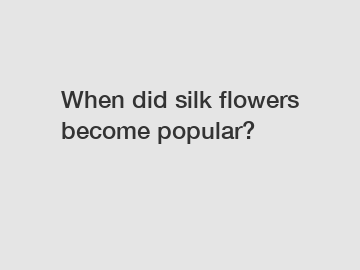Feb. 02, 2024
Gifts & Crafts
When Did Silk Flowers Become Popular?
Silk flowers have been a popular decoration choice for centuries, offering a lasting and low-maintenance alternative to real flowers. These fabric blooms can be found in homes, offices, and events, providing an elegant touch to any setting. But when did silk flowers become popular? Let's explore the history and evolution of this floral trend.
The Origins of Silk Flowers.

Silk flowers can be traced back to ancient China, where silk production began around 2,700 BC. The Chinese were the pioneers in silk flower making, using their expertise in silk weaving to create realistic and intricate floral designs. These early silk flowers were crafted using silk threads that were dyed and shaped into petals, stems, and leaves. The craftsmanship and attention to detail made these creations highly sought after.
The Spread of Silk Flower Making.
Silk flower making gradually spread beyond China's borders and gained popularity in other parts of Asia. In Japan, the art of creating silk flowers, known as "kanzashi," became widespread during the Edo period (1603-1868). Kanzashi were often worn as hair ornaments and were made using silk and other materials like gold, silver, and tortoiseshell.
Silk flowers also made their way to Europe during the Renaissance period. Wealthy nobles and royalty adorned their homes with luxurious silk flower arrangements that were imported from the Far East. However, it wasn't until the 18th century that Europeans began to produce their own silk flowers, thanks to advancements in textile manufacturing.
The Industrial Revolution and Silk Flower Production.
The Industrial Revolution, which spanned from the late 18th to the early 19th century, brought significant advancements in technology and manufacturing processes. These developments had a profound impact on the production of silk flowers, making them more accessible to the general population.
The invention of the sewing machine in the mid-19th century revolutionized the silk flower industry. This new technology enabled faster and more efficient production, allowing for mass-produced silk flowers at a lower cost. As a result, silk flowers became more affordable and increasingly popular among people of all backgrounds.
The Popularity of Silk Flowers Today.
Silk flowers have stood the test of time and remain popular even in the age of fresh flower arrangements and artificial materials. Modern manufacturing techniques have continued to improve the quality and realism of silk flowers, making it difficult to distinguish them from their natural counterparts.
Today, silk flowers are used in a variety of settings, ranging from home decor to wedding bouquets. They offer numerous advantages over real flowers, including durability, low maintenance, and the ability to retain their beauty over time. Additionally, silk flowers are a more sustainable option, as they do not contribute to the demand for fresh flowers, which often involves the exploitation of natural resources.
In conclusion, silk flowers have a rich history that spans across centuries and continents. From their origins in ancient China to their global popularity today, silk flowers have continuously evolved and adapted to changing times. Whether used as decorative accents or fashion accessories, silk flowers have become an integral part of many cultures and celebrations.
If you are looking to add a touch of elegance to your home or event, consider using silk flowers. Their timeless beauty and longevity make them a fantastic choice. For more information or assistance, please do not hesitate to contact us.
Keywords: contact us.
Are you interested in learning more about artificial hydrangeas manufacturer, wholesale artificial foliage, silk greenery wholesale? Contact us today to secure an expert consultation!
If you are interested in sending in a Guest Blogger Submission,welcome to write for us!
All Comments ( 0 )